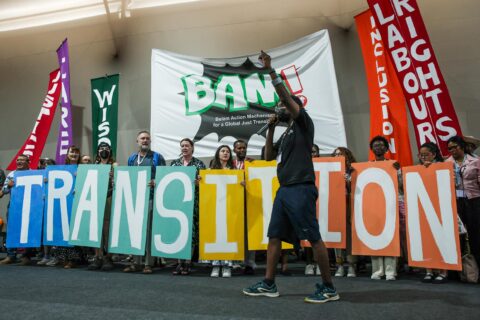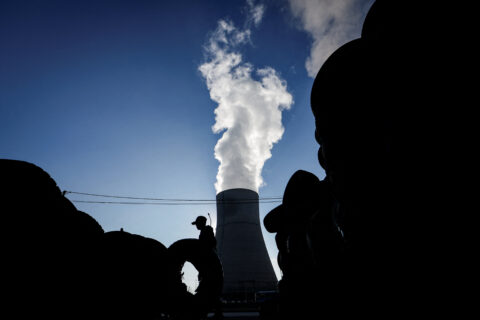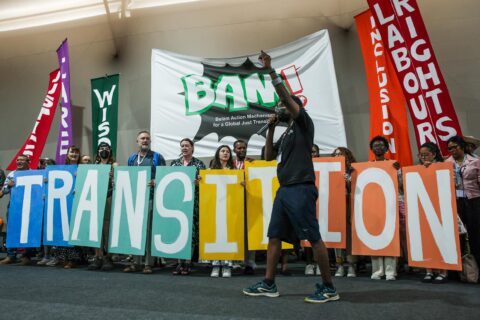More than 70% of European cities are not adapting to climate change in a consistent and coherent way.
That is the headline finding of our new study, published in Nature Climate Change, on how European cities are – or are not – preparing for a warming world.
We find that nearly half of the 327 cities that we assess have not published an adaptation plan, leaving us unsure as to whether or how they are trying to reduce climate threats.
For the 167 cities that do have adaptation plans – ranging from Alborg and Aarhus in Denmark through to Zilona Gorá in Poland and Zaragoza in Spain – we find that the climate-related measures within them are often inconsistent.
In other words, their climate risk assessments, policy goals, adaptation measures and monitoring programmes are not aligned.
For example, 81 plans identified the increased risk of storms and winds from climate change, but only 23 of these plans (28%) mentioned increasing resilience to such severe weather events as a specific policy goal.
These inconsistencies contribute to a “gap” that the UN has identified between the adaptation goals that societies have adopted and the measures they have implemented to try and meet them.
Our study finds that Nuremberg in Germany has the largest gap in its adaptation plan, with Stuttgart and Schwerin in Germany and Birmingham in the UK close behind.
The gap is particularly alarming because Europe is warming twice as fast as any other continent – and it is a continent that has had considerable financial and institutional support for adaptation for decades.
Consistent and coherent
Much of the existing research into the “adaptation gap” focuses on the difference between the climate measures a city needs and what action has actually been taken.
But there is another key part of the adaptation gap – whether the policies and measures are actually internally consistent.
Ideally, we would expect adaptation efforts to be “joined-up” along the policy chain.
For example, where climate risk assessments suggest that a city faces specific threats from storms, flash flooding, heatwaves, forest fires or drought, these vulnerabilities should be linked directly to the municipality’s adaptation goals, policies and the monitoring and evaluation processes.
Additionally, we might hope that city governments would involve those at risk from severe climate impacts, such as vulnerable population groups, industries and sectors of the economy, in decisions as to how they will be protected.
If these different phases of adaptation management are misaligned and inconsistent, we can see how cities and societies are less likely to deal with the impact of severe weather events effectively.
‘Consistency checks’
We developed a series of “consistency checks” to identify the extent to which different stages of the adaptation management process are aligned.
These include:
- Consistency between hazards identified in a risk assessment and a city’s adaptation goals.
- Consistency between the risks to specific sectors and detailed policy measures.
- Consistency between the risks faced by vulnerable groups and detailed policy measures.
- Consistency between the policy measures targeted at vulnerable groups and monitoring and evaluation processes to ensure they are being implemented.
- Consistency between the risks faced by vulnerable groups and their involvement in decision-making.
We use these checks to assess the adaptation strategies of European cities. For this, we use an existing dataset of the local adaptation plans of more than 300 cities.
(The dataset covers the 27 member countries of the EU, plus the UK. It aims to cover around 20% of the population of each country and include national and regional capitals where possible. In general, it covers large cities with more than 250,000 people and medium-size urban areas with more than 50,000 people.)
We find that nearly half (49%) of the plans do align climate risks with climate goals. Slightly more than half (52%) align identified sectoral risks with respective measures, but only regarding specific economic sectors and industries.
For example, 68 cities (77%) identify particular risks for buildings, while 70 cities (80%) highlight risks to the water industry and include details of measures to protect these sectors.
However, identified risks for vulnerable groups, such as risks for older people, those on low-incomes and ethnic minorities, were only followed-up with consistent measures in 43% of the plans.
Also, only 4% of cities consider or involve vulnerable groups in monitoring and evaluation (if they identified these groups at risk) – and only 1% of cities were effectively engaging vulnerable communities in plan development.
Given that the least powerful members of society are often the most vulnerable to climate change, there is a real risk that they will be further exposed to severe weather events.
Overall, when assessing each of the five consistency checks in all 167 plans, we find inconsistencies in more than two-thirds (70%). This is despite the fact that adaptation planning in Europe has improved over time – as we highlighted in a previous Carbon Brief article.
The findings are illustrated in the map below, which shows the 167 cities with adaptation plans. The coloured dots indicate the extent to which each city’s plan is inconsistent (indicating a potential adaptation gap) – taken as an average across the five checks set out in our study.
Green dots indicate plans that are fully consistent, with a sliding scale of inconsistency through yellow, orange and red. The maximum inconsistency identified in the study is an adaptation gap of 79.6% – found in Nuremberg, Germany. But Stuttgart and Schwerin in Germany and Birmingham in the UK are close behind, with an average “gap” score of more than 78%.

Lack of adaptation plans
Significantly, our research finds that only 167 of the 327 cities – just over half of those in the database – had even produced a climate adaptation plan by the study’s cut-off date of December 2020.
As such, we were unable to assess how a huge number of places across Europe are planning to deal with climate threats – regardless of whether their activities are misaligned or not.
(Although many cities will have published adaptation plans since this date, it is not clear how coherent their activities are likely to be, nor whether they take sufficient account of the needs of vulnerable groups.)
Overall, our research suggests a greater need for city and national governments to base their adaptation policies on robust risk assessments and to monitor progress accordingly – particularly with the most vulnerable social groups in society in mind.
Our findings highlight the importance of focusing on those who are most vulnerable to climate change, by involving them in decision-making and targeting specific measures at these groups.
The post Guest post: More than 70% of adaptation plans for European cities are ‘inconsistent’ appeared first on Carbon Brief.
Guest post: More than 70% of adaptation plans for European cities are ‘inconsistent’
Climate Change
COP30 fails to land deal on fossil fuel shift but triples finance for climate adaptation
After all-night talks, governments at COP30 agreed on Saturday to launch limited initiatives to strengthen emissions-cutting plans, as well as tripling finance to help poor countries cope with worsening climate change impacts by 2035. But the Amazon summit’s outcomes fell short on the global transition away from oil, gas and coal.
In an effort to deliver something on fossil fuels, the Brazilian presidency complemented the final Belém package by promising to create roadmaps on transitioning away from fossil fuels and protecting forests – as requested by Brazilian President Lula da Silva.
Brazil tabled its roadmap proposal at the eleventh hour as a compromise solution after some nations – especially European and Latin American states – voiced disappointment that a formal deal was not reached on one after strong pushback from large fossil fuel producers led by Saudi Arabia.
Brazil’s roadmap process will sit outside the UN climate regime. It will be supported by other countries such as Colombia, which is organising the first global conference on the issue, said COP30 president André Aranha Corrêa do Lago. He added that he will also craft a second roadmap to halt and reverse deforestation and report back to the COP on them both.
“We know some of you had greater ambition for some of the issues at hand,” Corrêa do Lago told a closing plenary. “I will try not to disappoint you.”
After week-long row, COP30 fails to mention fossil fuels
After more than 80 countries called for a roadmap to phase down oil, coal and gas to be kickstarted at COP30, observers said fossil fuel heavyweights, including Gulf States, Russia and India, had insisted it stay out of the final Global Mutirão decision adopted in Belém, along with any explicit mention of fossil fuels.
On Friday, the European Union and the UK had fought hard against that opposition but ultimately had to settle for two new processes that are meant to reinforce ambition and implementation of countries’ national climate plans (NDCs), with reports and a high-level dialogue due next year.
Before the final plenary, EU Climate Commissioner Wopke Hoekstra said it had been “an intense and sometimes difficult week and evening”, adding “we would have liked to have more”. But, he said, “we think we should support [the COP outcome] because at least it is going in the right direction.”
The Mutirão text encourages countries ”to strengthen their existing nationally determined contribution at any time with a view to enhancing its level of ambition” and calls on them to accelerate their implementation “while striving to do better collectively and cooperatively”.
In a last-minute push, Colombia – which championed a declaration to transition away from oil, coal and gas – told the closing plenary the country was “left with no other choice” but to object to the outcome of the dedicated mitigation track on emission-cutting efforts unless a mention to fossil fuels was added. After the presidency tried to dismiss concerns, Colombia insisted and the plenary was suspended.


Developed countries – especially the EU – had felt isolated in their push for stronger language on emission-cutting measures after failing to win vocal support from traditional allies such as the Alliance of Small Island States (AOSIS) and the Least Developed Countries (LDCs).
That was mainly because of Europe’s inability to make a compelling offer on finance for adaptation, negotiators and observers said.
“Adaptation COP” triples finance for climate resilience
A demand from the world’s poorest nations to triple adaptation finance was agreed, but only by a deadline of 2035 rather than 2030, and without a clear number.
However, the main Mutirão decision urges developed countries to increase their collective provision of climate finance for adaptation to the Global South. It also sets up a two-year process on climate finance as well as a high-level ministerial roundtable to discuss progress towards meeting the new climate finance goal agreed last year at COP29.
That COP29 goal sets a target for rich nations to provide $300 billion a year for climate action by 2035 – and the tripling of adaptation finance decided in Belem will be part of this, as the EU had insisted.
“It is very clear that we should stand shoulder to shoulder with the poorest nations,” the EU’s climate chief Wopke Hoekstra said before the final conference session began.
Some African ministers gave the outcome on adaptation finance a cautious welcome. But many countries – including the EU, some Latin American states, Switzerland and Canada – were angry about a text that adopted indicators to measure progress on adaptation efforts.
They made interventions rejecting the decision on a new Global Goal on Adaptation (GGA) – expected to be a flagship outcome at this COP – which included a rewritten and shortened list of metrics to measure progress on climate resilience originally developed by technical experts.
Jiwoh Abdulai, environment minister of Sierra Leone, said they had worked tirelessly to craft a set of indicators that would reflect “lived realities” on the ground, but are now left with “unclear, unmeasurable and – in many cases – unusable” ones.
“For us, this is not technical, this is about our survival,” he added before the plenary was suspended.
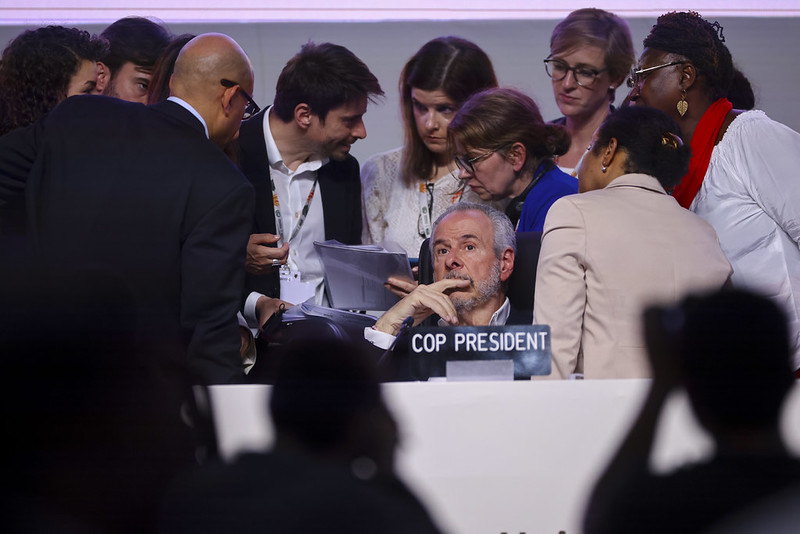

Trade and just transition land wins in Belém deal
As the Belem political package was adopted to muted applause from countries, campaigners at the back of the room whooped with joy as the conference approved a decision on just transition.
They and developing countries had swung behind a new “Belém Action Mechanism”, intended to serve as a hub to support countries in taking concrete steps to ensure their shift from dirty to clean energy systems is fair and equitable.
The Mutirão decision also includes trade, another key issue that was not on the official negotiating agenda, along with long-term climate finance and the gap in emissions-cutting ambition.
Annual dialogues will take place at the next three mid-year Bonn sessions on boosting international cooperation on trade – an emerging economy priority in the context of a carbon levy on imports proposed by the EU.
Experts said the inclusion of trade in a COP decision was a big win for China. “For the first time, trade is elevated alongside mitigation and finance as a critical third pillar for climate progress,” said Kate Logan, director of China Climate Hub at the Asia Society Policy Institute, adding that this “is likely to remain a key arena for China’s influence” in the climate regime.
The decision reaffirms that “measures taken to combat climate change, including unilateral ones, should not constitute a means of arbitrary or unjustifiable discrimination or a disguised restriction on international trade”.
The post COP30 fails to land deal on fossil fuel shift but triples finance for climate adaptation appeared first on Climate Home News.
https://www.climatechangenews.com/2025/11/22/cop30-brazil-deal-fossil-fuel-transition-fails-triples-finance-climate-adaptation/
Climate Change
COP30 fails to land deal on fossil fuel transition but triples finance for climate adaptation
After all-night talks, governments at COP30 agreed on Saturday to launch limited initiatives to strengthen emissions-cutting plans, as well as tripling finance to help poor countries cope with worsening climate change impacts by 2035. But the Amazon summit’s outcomes fell short on the global transition away from oil, gas and coal.
In an effort to deliver something on fossil fuels, the Brazilian presidency complemented the final Belém package by promising to create roadmaps on transitioning away from fossil fuels and protecting forests – as requested by Brazilian President Lula da Silva.
Brazil tabled its roadmap proposal at the eleventh hour as a compromise solution after some nations – especially European and Latin American states – voiced disappointment that a formal deal was not reached on one after strong pushback from large fossil fuel producers led by Saudi Arabia.
Brazil’s roadmap process will sit outside the UN climate regime. It will be supported by other countries such as Colombia, which is organising the first global conference on the issue, said COP30 president André Aranha Corrêa do Lago. He added that he will also craft a second roadmap to halt and reverse deforestation and report back to the COP on them both.
“We know some of you had greater ambition for some of the issues at hand,” Corrêa do Lago told a closing plenary. “I will try not to disappoint you.”
After week-long row, COP30 fails to mention fossil fuels
After more than 80 countries called for a roadmap to phase down oil, coal and gas to be kickstarted at COP30, observers said fossil fuel heavyweights, including Gulf States, Russia and India, had insisted it stay out of the final Global Mutirão decision adopted in Belém, along with any explicit mention of fossil fuels.
On Friday, the European Union and the UK had fought hard against that opposition but ultimately had to settle for two new processes that are meant to reinforce ambition and implementation of countries’ national climate plans (NDCs), with reports and a high-level dialogue due next year.
Before the final plenary, EU Climate Commissioner Wopke Hoekstra said it had been “an intense and sometimes difficult week and evening”, adding “we would have liked to have more”. But, he said, “we think we should support [the COP outcome] because at least it is going in the right direction.”
The Mutirão text encourages countries ”to strengthen their existing nationally determined contribution at any time with a view to enhancing its level of ambition” and calls on them to accelerate their implementation “while striving to do better collectively and cooperatively”.
In a last-minute push, Colombia – which championed a declaration to transition away from oil, coal and gas – told the closing plenary the country was “left with no other choice” but to object to the outcome of the dedicated mitigation track on emission-cutting efforts unless a mention to fossil fuels was added. After the presidency tried to dismiss concerns, Colombia insisted and the plenary was suspended.


Developed countries – especially the EU – had felt isolated in their push for stronger language on emission-cutting measures after failing to win vocal support from traditional allies such as the Alliance of Small Island States (AOSIS) and the Least Developed Countries (LDCs).
That was mainly because of Europe’s inability to make a compelling offer on finance for adaptation, negotiators and observers said.
“Adaptation COP” triples finance for climate resilience
A demand from the world’s poorest nations to triple adaptation finance was agreed, but only by a deadline of 2035 rather than 2030, and without a clear number.
However, the main Mutirão decision urges developed countries to increase their collective provision of climate finance for adaptation to the Global South. It also sets up a two-year process on climate finance as well as a high-level ministerial roundtable to discuss progress towards meeting the new climate finance goal agreed last year at COP29.
That COP29 goal sets a target for rich nations to provide $300 billion a year for climate action by 2035 – and the tripling of adaptation finance decided in Belem will be part of this, as the EU had insisted.
“It is very clear that we should stand shoulder to shoulder with the poorest nations,” the EU’s climate chief Wopke Hoekstra said before the final conference session began.
Poorest countries appeal for more adaptation finance at COP30
Some African ministers gave the outcome on adaptation finance a cautious welcome. But many countries – including the EU, some Latin American states, Switzerland and Canada – were angry about a text that adopted indicators to measure progress on adaptation efforts.
They made interventions rejecting the decision on a new Global Goal on Adaptation (GGA) – expected to be a flagship outcome at this COP – which included a rewritten and shortened list of metrics to measure progress on climate resilience originally developed by technical experts.
Jiwoh Abdulai, environment minister of Sierra Leone, said they had worked tirelessly to craft a set of indicators that would reflect “lived realities” on the ground, but are now left with “unclear, unmeasurable and – in many cases – unusable” ones.
“For us, this is not technical, this is about our survival,” he added before the plenary was suspended.
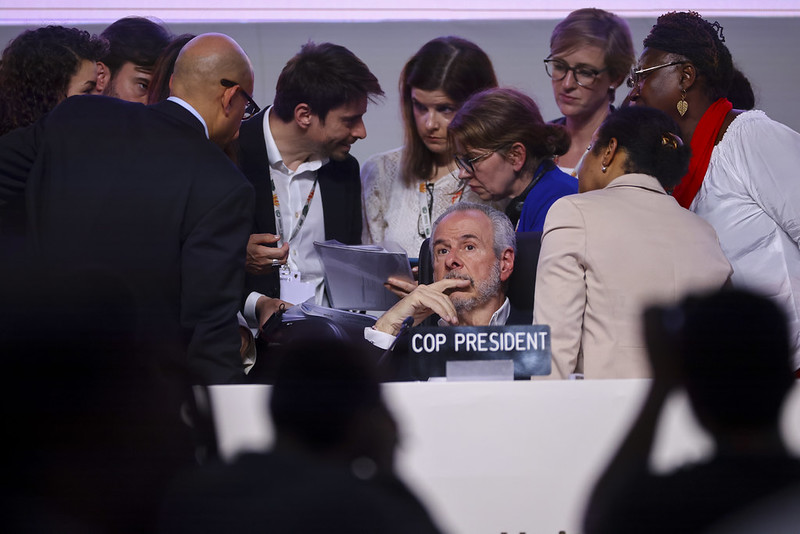

Trade and just transition land wins in Belém deal
As the Belem political package was adopted to muted applause from countries, campaigners at the back of the room whooped with joy as the conference approved a decision on just transition.
They and developing countries had swung behind a new “Belém Action Mechanism”, intended to serve as a hub to support countries in taking concrete steps to ensure their shift from dirty to clean energy systems is fair and equitable.
The Mutirão decision also includes trade, another key issue that was not on the official negotiating agenda, along with long-term climate finance and the gap in emissions-cutting ambition.
Annual dialogues will take place at the next three mid-year Bonn sessions on boosting international cooperation on trade – an emerging economy priority in the context of a carbon levy on imports proposed by the EU.
Experts said the inclusion of trade in a COP decision was a big win for China. “For the first time, trade is elevated alongside mitigation and finance as a critical third pillar for climate progress,” said Kate Logan, director of China Climate Hub at the Asia Society Policy Institute, adding that this “is likely to remain a key arena for China’s influence” in the climate regime.
The decision reaffirms that “measures taken to combat climate change, including unilateral ones, should not constitute a means of arbitrary or unjustifiable discrimination or a disguised restriction on international trade”.
The post COP30 fails to land deal on fossil fuel transition but triples finance for climate adaptation appeared first on Climate Home News.
COP30 fails to land deal on fossil fuel transition but triples finance for climate adaptation
Climate Change
Your Summary of Negotiations: Nov. 22
There’s been a lot of chatter about Roadmaps in Belem. The WWF and Greenpeace have led a call for a roadmap to end deforestation. Currently, 45 countries have indicated support. More than 80 countries have called for a roadmap to phase out fossil fuels. Additionally, there are four other roadmaps on finance from developed to developing countries. Climate Action Network wonders, “Roadmap or mazes? Will those lead us somewhere, or will we be even more lost with so many of them?!”
Brazil’s TFFF plan has raised $5.5bn — far below even Brazil’s reduced target of $10bn by next year. Norway, Brazil, Indonesia, Portugal, France, and the Netherlands have all committed to pay into the fund, while Germany has said it will announce its contribution soon. The UK and China, on the other hand, do not plan to pay in.
Away from COP30 negotiations, talks continued over the COP31 host, with Türkiye and Australia striking a compromise: Türkiye will host the conference, and Australia’s climate change and energy Minister, Chris Bowen, as COP president, will chair the talks.
UN Secretary General, António Guterres, returned to Belém on Thursday to urge the world’s nations to find compromises in the final hours of COP30 and deliver a deal to accelerate climate action: “We are down to the wire and the world is watching… The world must pursue a just, orderly, and equitable transition away from fossil fuels.”
On Tuesday, COP30 hosts Brazil produced a first draft of an agreement between nations at the UN climate talks after negotiations on the sticking points stretched late into the night. The nine-page “Global Mutirao” document – a reference to an Indigenous concept of uniting toward a common goal – came after Brazil on Monday urged delegates to work day and night to produce an agreement by midweek.
Over the next few days, negotiations intensified. On Friday morning, the Presidency published its new mutirão text that contains no mention of a phase-out of fossil fuels. At least 29 nations threatened to block any draft without this phase-out and then rejected the text. The letter states, “We cannot support an outcome that does not include a roadmap [on fossil fuels].” Countries that signed the letter in favor of the fossil fuel phase-out include: Austria, Belgium, Chile, Colombia, Costa Rica, Croatia, Czechia, Estonia, Finland, France, Germany, Guatemala, Honduras, Iceland, Ireland, Liechtenstein, Luxembourg, the Marshall Islands, Mexico, Monaco, the Netherlands, Panama, Palau, Slovenia, Spain, Sweden, Switzerland, the UK and Vanuatu. Another bloc of around 80 countries, that includes Saudi Arabia, Russia and some other petrostates, as well as some countries dependent on consuming fossil fuels is negotiating against the fossil fuel phase out roadmap.
Colombia and the Netherlands also announced that they will co-host the First International Conference on the Just Transition Away from Fossil Fuels in Santa Marta, Colombia, in April next year.
The climate talks are now likely to continue into the weekend. The European Union’s commissioner for climate, Wopke Hoekstra, warned there was a risk of no agreement being reached, and expressed dismay at the current text saying there was no science, no mention of a transition for fossil fuels, no global stocktake.
No UN climate conference has finished on time since 2003.

Aside from the fossil fuel debate, other issues also remain to be resolved, including a response to the fact that countries’ national climate plans are too weak to limit global heating to 1.5C above preindustrial levels as set out in the 2015 Paris agreement, and questions of finance, trade and transparency, and how much cash developing countries will receive to help them adapt to the impacts of the climate crisis.
The issue of gender has become contentious and has been lifted by the COP30 Presidency from technical negotiations to a higher political level with ministers. Conservative nations — from the Vatican to Iran — are pushing to narrow the definition of gender at COP30 to exclude trans and non-binary people, which threatens to increase the difficulty of already torturous negotiations. The effort uses footnotes in key texts to attach country-specific interpretations. Paraguay, Argentina, Iran, Indonesia, Malaysia, as well as the Vatican have so far entered footnotes into the draft Gender Action Plan (GAP) meant to guide work for the next decade. Similar footnotes have also appeared in a text related to the “just transition” — the framework to shift to environmentally sustainable economies without leaving workers and communities behind.
Outside the negotiating rooms, civil society groups have complained about the “militarization” of the COP30 venue, which is now guarded by heavily armed officers in riot gear following UNFCCC chief Simon Stiell’s complaints earlier. Indigenous activists say they feel particularly targeted.
The Global Afro Descendants Climate Justice Collaborative is calling for Afro-Descendant peoples to be recognized as a formal constituency within the UNFCCC. Their petition states, “For generations, Afro-Descendant and African communities have been at the heart of global struggles for equity, justice, and renewal. We are the descendants of those who cultivated, resisted, and rebuilt. We have carried the wisdom of sustainable living, the memory of displacement, and the spirit of resilience that continues to sustain our planet.” Read the full letter here. Meanwhile, the European Union, the United Kingdom, and Australia are explicitly opposing the inclusion of references to people of African descent in the Gender Action Plan, acting to silence and delegitimize legitimate and historically grounded demands.
“Simple message about COP30,” said Dr. Sam Grant, “This is a place of virulent anti-blackness.”
While a formal constituency is yet to be established, the Global Afrodescendant Climate Justice Collaborative announced Friday that for the first time, people of African descent appear in UNFCCC COP decisions and are referenced across multiple strands of negotiating texts. The texts are not finalized. “Nonetheless we are calling it a win to have people of African descent in the draft decisions,” said Mariama Williams of the GACJC.
Youth activists, more than 30,000 young people from over 100 countries, held a series of Youth-Led Forums and outlined calls for “full, fast, fair fossil phase-out,” institutionalizing intergenerational equity, moves toward peace, climate finance centered on justice, and adaptation “as a moral and political priority”.
The People’s Plenary was scheduled on Thursday, a space where civil society at COP comes together to make clear what their expectations and demands are of the negotiations, as we near the close. But a fire broke out in the Blue Zone, and the venue was evacuated. The fire has been contained with limited damage, and no serious injuries have been reported. Hosts report the fire was electrical.
There are more than 300 industrial agriculture lobbyists at COP30. According to DeSmog, the number of lobbyists representing the interests of industrial cattle farming, commodity grains, and pesticides is up 14 percent over last year’s summit in Baku — and is larger than the delegation of the world’s 10th largest economy, Canada, which brought 220 delegates to COP30 in Belém. Agriculture is responsible for 25 – 30% of global emissions.
We will continue to follow negotiations and hope to share the final agreements in our final window into COP30 Digest, scheduled to be released on December 3. Stay tuned.
Photo credit: Kiara Worth
The post Your Summary of Negotiations: Nov. 22 appeared first on Climate Generation.
-
Climate Change3 months ago
Guest post: Why China is still building new coal – and when it might stop
-
Greenhouse Gases3 months ago
Guest post: Why China is still building new coal – and when it might stop
-
Climate Change2 years ago
Spanish-language misinformation on renewable energy spreads online, report shows
-

 Greenhouse Gases1 year ago
Greenhouse Gases1 year ago嘉宾来稿:满足中国增长的用电需求 光伏加储能“比新建煤电更实惠”
-
Climate Change Videos2 years ago
The toxic gas flares fuelling Nigeria’s climate change – BBC News
-

 Climate Change1 year ago
Climate Change1 year ago嘉宾来稿:满足中国增长的用电需求 光伏加储能“比新建煤电更实惠”
-

 Carbon Footprint2 years ago
Carbon Footprint2 years agoUS SEC’s Climate Disclosure Rules Spur Renewed Interest in Carbon Credits
-
Renewable Energy4 months ago
US Grid Strain, Possible Allete Sale







